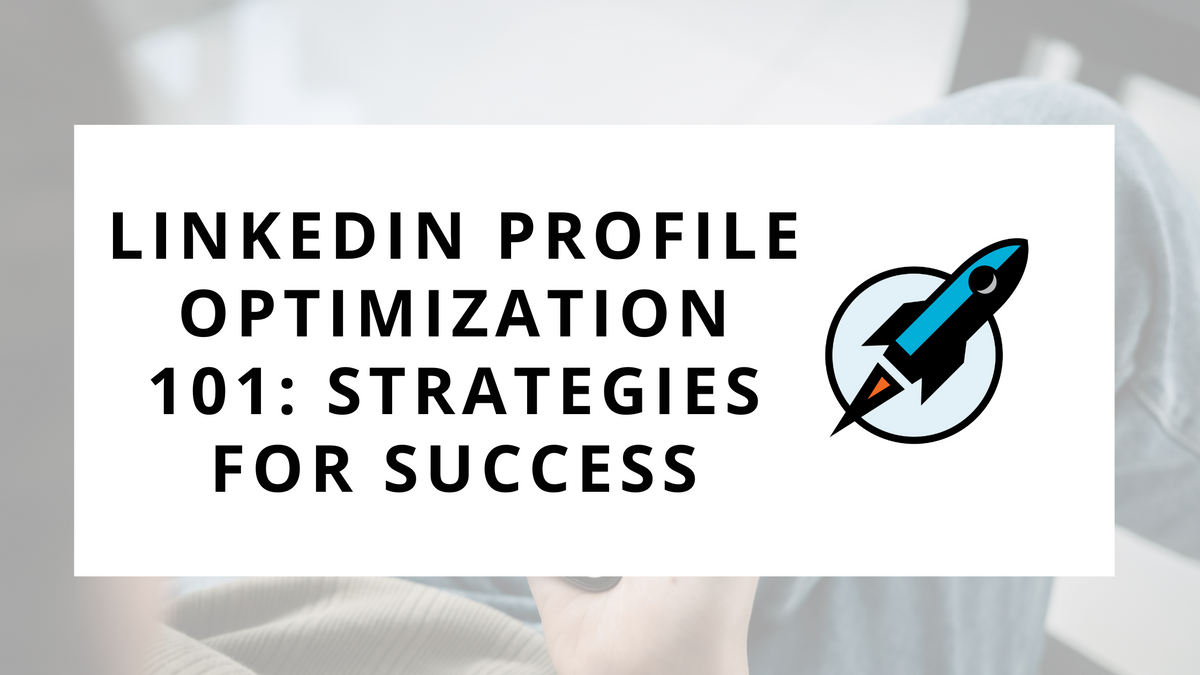LinkedIn Profile Optimization 101: Strategies for Success

In today's interconnected digital landscape, networking has taken on an entirely new dimension.
Gone are the days when business cards and industry events were the primary means of establishing professional connections. In the age of social media dominance, LinkedIn has emerged as the go-to platform for career-oriented individuals, with over 774 million members worldwide.
While many view LinkedIn as a mere online resume or job search tool, the truth is that it holds immense potential for professional growth and development.
Your LinkedIn profile is more than just a digital representation of your work history; it is a powerful personal brand-building tool that can open doors to career opportunities, collaborations, and industry recognition.
Optimizing your LinkedIn profile goes beyond uploading a headshot and adding your current job title. It involves strategically curating your personal brand, telling the story of what you do, and engaging with a vast network of professionals who could become invaluable assets in your strategy.
In this article, we'll delve into the importance of optimizing your LinkedIn profile and explore the various elements that can transform it from a static online presence to a dynamic platform that attracts attention and unlocks countless opportunities.
Spoiler: It’s Not An Online Resume
One of the biggest mistakes I see people make with their LinkedIn profile is turning it into a giant online resume.
They use valuable featured space on their profile to highlight their job titles and promote their personal brand through career achievements like:
- Attainted Presidents Club in 2018, 2021, 2022
- Assessed client needs based on current objectives, supply and demand, and seasonable variables.
- Serviced manufacturing client accounts for 20 organizations providing revenue of $1m per year or more.
DO NOT DO THIS!
Unless you are looking for a job… and even then, I’d still recommend you make your profile focus more on what you have to offer versus what you have done in the past.
Remember, your audience is trying to make a change. They have a problem and want to find somebody who can solve it for them.
Your profile should quickly and clearly highlight that you can help them. It should focus on who you help, how you help them, and how you can impact their business.
Your customers don’t care if you hit President’s Club or have expanded into new territories. They want to know if you can solve their problems.
Your Landing Page For Social Activity
Instead of viewing your profile as an online resume, you should see it as the landing page for your social activity.
As you create content, add connections, and comment on posts, you are actively sending people back to your profile.
When they get there, what do you want them to do?

Most profiles don’t have a clear next step.
This is a major mistake! If somebody is viewing your profile, you have a captive audience. This is your opportunity to get them to take action.
So how do you do it?
The Grunt Test
Enter the Grunt Test.
If a caveman (somebody with limited knowledge) visited your profile, could they “grunt” out the answer to these three questions within five seconds:
- What do you do?
- Who do you it for?
- What is the next step to work with you?
The key here is clarity.
Every visitor to your profile should be able to quickly answer those questions. If they can’t, you are missing an opportunity to convert your profile visitors into prospects.
Getting Started with Profile Optimization
So, now let’s talk about the basics of profile optimization.
What do you need to do to pass the grunt test?
Below is a quick overview of how you should be optimizing each part of your profile. If you want more detailed help, check out my course on the topic. It includes videos and a worksheet to guide you through the process.
Here’s what I recommend:
Headshot - You need to have a professional profile picture. This is essentially your logo for your personal brand. It should give off a vibe that is relevant for both you personally and the industry you are working in. If you don’t already have one, you can look into getting AI-generated images.
Headline - This text is essential to get it right. Not only does it show up on your profile itself, but also next to your picture on the newsfeed and in the comments. Your headline should be a mini elevator pitch. Quickly tell people what you do, who you do it for, and the impact you create.

About Section - The About section should be an expansion on your elevator pitch, but add in your experience and authority. Tell people why they should trust you. You should also use this space to tell people how they can work with you by providing calls-to-action (CTAs). Encourage them to send you a direct message, book a call, or email you.
Experience Section - Use your experience to tell the story of how you help people through the products and services you sell. Briefly explain the solution to their problems. Don’t make it a resume! Also, include featured links and media (videos, white papers, etc.). This is an excellent spot for another call to action.

Skills - While this section likely isn’t going to make or break a prospect's decision to work with you, I do recommend adding and highlighting skills that are meaningful for the work that you do. Don’t make “Microsoft Word” a top skill. Instead, do something using industry and change specific skills like “Process Improvement Strategy” or “Enterprise Software Implementation.”
Endorsements - An underrated part of the profile is the endorsements section. This is a spot for your past customers, co-workers, or business partners to leave quick testimonials about your work. I highly recommend you both give and receive endorsements.
Of course, there is always more optimization to be done. However, if you can knock out the items above, you’ll be off to a great start. The key is to remember that your prospects are trying to make a change. Make it clear how you help them with it.

This week’s action items are about improving your LinkedIn profile's performance.
As the landing page of your social selling activity, you NEED to optimize it to be successful. With more clarity comes more conversions!
Spend some time this week to do the following:
- Use the Grunt Test - Check your profile against the Grunt Test. If your ideal customer lands on your profile, could they answer those three questions: What do you do? Who do you do it for? What is the next step work for you?
- Optimize Your Profile - Go through the items above to ensure your profile is optimized. Focus on telling the story of how you help your customers. For more detailed information on profile optimization, including section-by-section videos and a worksheet, you can check out my course, “Ultimate LinkedIn Profile For Sales Reps.”
- Use the Grunt Test (again) - Once you’ve finished optimizing your profile, go back and try the Grunt Test again. Did you pass this time? Or do you have more updates you need to make?
Remember, all the effort you put into social selling is wasted if you cannot get potential customers to understand what you do and how to work with you. Make sure your profile is optimized so you can maximize the ROI of your strategy!
